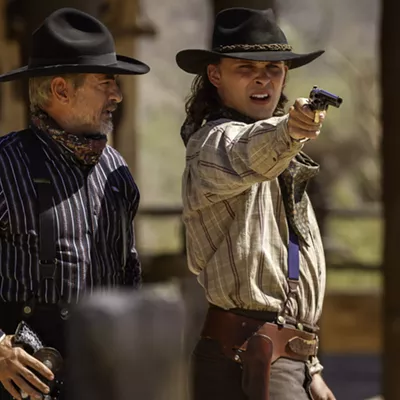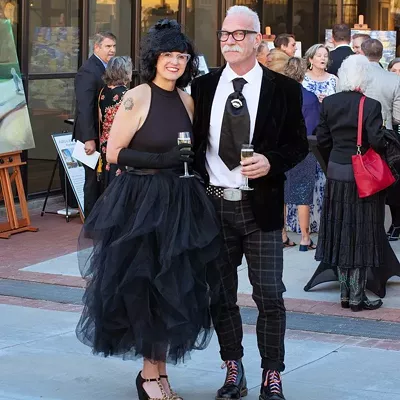Miles Conrad is still hard at work fixing up a space at the historic Steinfeld warehouse on the west side of downtown.
He's been at it since last fall, when he moved his Conrad Wilde Gallery from Sixth and Sixth.
"I think I bit off more than I can chew," he says, half joking. "WAMO (Warehouse Arts Management Organization) is still installing electrical service. I work from a generator out back."
The nonprofit WAMO has been renovating the much-loved old building at 101 W. Sixth St., which dates to 1907. The roof has been repaired, but without water service or electricity, Conrad can't yet open his doors to the public regularly. On the plus side, he's not paying rent yet and his new space is three times the size of his last one. And he has been enthusiastically curating exhibitions for the occasional Saturday evening reception.
During the First Saturday gallery openings from 6 to 9 p.m. this Saturday, he's exhibiting lush abstract oils by longtime gallery artist Emilia Arana and David A. Clark's delicate encaustic monotypes. Arana is experimenting with lovely, subtle colors, Conrad says, and Clark's new work is so "beautiful I fell in love with it." The show continues by appointment through May 24.
While Conrad is working on his new space at the fringes of downtown, the city center is losing three galleries in rapid succession.
ATLAS has already closed, Sacred Machine is shutting down May 31 and Obsidian is pulling out soon, probably in early June. A fourth gallery, The Drawing Studio, may depart by the end of the year.
Those losses are balanced somewhat by the addition of Baker + Hesseldenz, opening May 20 at 100 E. Sixth St., at Seventh Avenue. The designer-owners, Scott Baker (who ran Metroform gallery nearby years ago) and Mary Ann Hesseldenz, plan to exhibit contemporary photography and painting. And downtown's mainstay galleries—Etherton, Philabaum and Davis Dominguez—are carrying on.
Do-it-yourself galleries such as Conrad's once popped up regularly in cheap storefronts on Congress Street and its environs, triggered by their owners' love of art and powered by sweat equity. Think Dinnerware, Raw, Central Arts, Rocket, Bero, Platform and Industry. But today's shifting gallery scene raises the question of whether galleries can survive in the new downtown, flush with freshly constructed housing towers, pricey restaurants and glittery bars.
"I was hopeful downtown could be like it was in the 1970s," says Monica Prillaman, owner of Obsidian, located in a beautifully renovated space in the Historic Train Depot, 410 N. Toole Ave. "It was vibrant with department stores, little boutiques, all kinds of businesses. Now it's mostly student housing, restaurants and bars."
She and her son James moved Obsidian from St. Philip's Plaza in October 2011, eager to take part in the downtown renaissance. "I really loved doing this," Prillaman says. "It was so much fun."
Yet she believes the city should have done more to promote a better mix of businesses downtown, including more variety in retail shops and middle-class housing for professionals.
Still, she acknowledges that other woes also led to the decision to close. The narrative ceramic sculpture that she and James favor is not for everyone, she notes. The recession didn't help, and many of her buyers were tourists. When they left town for the summer, sales plummeted.
The Prillamans will continue to exhibit favorite artists as long as the doors are open.
"For sure we'll be here through May, and we'll do the Art Safari"—the collective opening of the city's central galleries on June 7.
Wild narrative ceramics by some out-of-towners are in the exhibition lineup. And an eclectic array of works by locals demonstrates that the gallery's closing means the loss of one more venue for Tucson artists. On view are mixed-media pieces by Julie Sasse, steel drawings by Gary Swimmer, "L.A. street art" by Brooke Grucella and painted portraits by Paula Wittner.
Sacred Machine Museum and Curiosity Shop, a fixture for four years at 245 E. Congress St., will close May 31. The 4-year-old gallery and music space primarily exhibited the paintings of Daniel Martin Diaz, a native Tucsonan heavily influenced by the skulls and saints of Mexican folk art. He also does public art, and he'll leave his stamp on downtown with his "Desert Splendor" adorning the parking garage up the street. A rock musician as well, Diaz and his wife, Paula Catherine Valencia, partner in the bands Blind Divine and Crystal Radio.
They're decamping for Los Angeles, but the move has nothing to do with changes in downtown Tucson, Valencia says.
"It's just timing for us," she explains. "We're trying to branch out. L.A. is more conducive to the music we do, and Daniel has a dealer and buyers out there."
The couple are proud to have played a part in downtown's revitalization, Valencia says. Their block had only three businesses when they opened in May 2010; now much of East Congress is hopping with restaurants and bars.
Sacred Machine will throw a farewell celebration from 5 to 10 p.m., Saturday, May 10, with performances by Crystal Radio and Blind Divine. Blue Print for the Future, an exhibition of posters of some of Diaz's most popular work, will debut that night and continue through the end of the month.
Albert Chamillard and his business partner, James Schaub, ran ATLAS Fine Arts Services for three years. An excellent small gallery on Sixth Avenue south of Congress, ATLAS exhibited carefully chosen contemporary abstract art. Both owners are artists—Schaub is a painter and Chamillard does "conceptual cross-hatching" drawings—and both plan to concentrate on their own art.
They had a good run with the gallery, Chamillard says cheerfully.
"The rent is going up but that's not necessarily a bad thing"—in his view, that means downtown is doing well. "But art galleries do need cheap space." He predicts small D.I.Y. galleries will continue to migrate toward the fringes of downtown, such as Conrad Wilde's new space on West Sixth Street, YAY Big Ideas on East Toole and Wee on North Sixth Avenue. He thinks the next frontier for galleries may be south of downtown.
Even in the good old days, when upstart galleries could afford spaces smack in the middle of downtown, they came and went. "What is now Atlas, Obsidian and Sacred Machine was Bero, Raw Gallery, Industry and Platform not that long ago," Chamillard says.
To Conrad, what's happening downtown fits a familiar narrative. First, artists colonize a crumbling downtown and help it get better. In Tucson a few years back, "it was the galleries on Congress that were holding down the block," he says. Second, when gentrification revs up, galleries are pushed out by soaring rents.
Given that dynamic, he says, it's essential that some arts spaces be protected.
"It's really important what WAMO is doing," he says. "Its mission is preserving arts spaces downtown."











